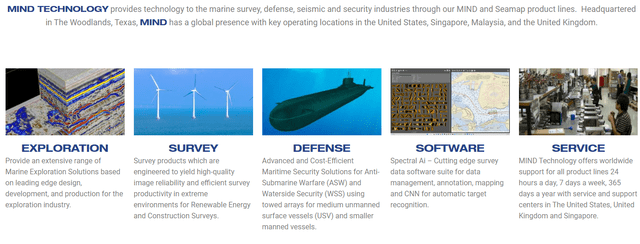I have been following MIND Technology (NASDAQ:MIND) and their associated preferred issue (NASDAQ:MINDP) as they seek to simplify their outstanding shares into a single class of common, eliminate the preferred overhang and free up the company to invest in growth. The conversion vote was postponed this past week, which I believe creates an attractive entry point into the preferred shares.
Background
Legacy MIND had three business divisions, but they have consolidated and after the recent sale of Klein rendered them debt-free, are focused on their Seamap product suite:
MIND Offerings (MIND website) Seamap Products (MIND Technology)

As you can see, MIND has begun offering an AI suite to analyze data from their products, and has continued a license this tech to the Klein buyer, General Oceans. Growth of recurring license revenue will help offset the very lumpy revenues in the business.
MIND is primarily selling their products into the offshore oil & gas and offshore wind markets, which have substantial tailwinds, and even hot sectors like carbon capture and sequestration. They are seeking to get more contracts in the defense space as well, but this is a nascent part of the business and currently comes through the General Oceans contract.
Conversion Proposal
The main overhang on the MIND business has been ~$50m face value of outstanding preferred & accrued dividends. It remains impractical for the business to fund these dividends due to working capital requirements to grow the business. As a result, the company made an offer to settle the obligation by issuing 2.7 common shares for each preferred share outstanding. It appears the preferred holders successfully bargained their way to a 3.9 to 1 conversion ratio.
Now, surprisingly, the vote got delayed again this past week, to June 27th. My understanding is this was due to technical voting issues, and not to material holdouts remaining among preferred shareholders, but until the vote clears, uncertainty remains. If the vote does not go through, further questions will emerge about how to settle this standoff.
Why Convert
If you read the latest MIND conference call transcript, a discussion took place about the cost of being such a small public company:
Ross Taylor
What are your public company costs you think? Would it be — are they in the $1 million annual range?
Rob Capps
Well, I’d say they’re more than that.
Ross Taylor
More than that. So going back to Tyson’s 8 million share math, we’re talking about public company costs are probably more than $0.12 a share annually at this stage, which would go away if you were to end up merging with another business.
Rob Capps
That’s the math.
My understanding is an issue with a merger while the preferred stock remains outstanding, is that the deal would be unworkable given their current change in control provision for the preferred (section 7). The formula basically gives the preferred a call option on converting into common in a deal, capping the upside for common shareholders. By converting to common, everyone should be able to obtain a sufficient piece of the pie to make a deal palatable in the future, if necessary.
Valuation
MIND reported $1.5m of EBITDA in Q1, which would run-rate at $6m a year. Given approximately 8m shares would be outstanding if the preferred conversion goes through, and common shares currently trade near $4.50 a share, the implied valuation here is $4.50*8 = $36m/6 = 6.0x EBITDA. This doesn’t seem particularly demanding, and given over $1m of cost takeout would be possible if they went private, a buyer would be looking at a ~5x multiple at current prices. The call also clarified that MIND cautiously expects Q2-Q4 to come in higher:
Rob Capps
Let me talk to one at a time. So as far as the revenue level, we do think we’ll see improvements later in the year. Obviously, based on the backlog, we have good visibility as to what we have to deliver. And it’s just a function of when people want it, when we can get it built, when key components come in, things like that impact actual delivery schedules. So that’s where you’ll see ups and downs. So I would expect that the revenue for the year would be at a higher level than if you were to annualize the first quarter. If that — I think answers your question.
Tyson Bauer
Right, we might have variability, but overall, you’re going to average higher quarterly levels.
Rob Capps
I think that’s fair to say. But again, there could be variability. Again, you have a $4 million order, and it slips a month or so if it has an impact. But generally speaking, I would agree with that. As far as EPS, I’m not sure I want to get into the game of trying to project the earnings per share, but I think it kind of gives you a base for where we think revenues are. I think our cost structure is been demonstrated to come in line. I think as we see higher revenues, just naturally we’ll see some improvement in margin. Not dramatically, but some additional absorption of overhead.
So $6m of EBITDA for the year is likely lowballing the earnings power of this business, but with it being lumpy, the market will likely wait for proof.
I prefer to get involved through the MINDP issue, as a 3.9/1 conversion ratio means you’re buying shares at an implied value of $13/3.9 = $3.33. If we assume $6m is the right EBITDA number, then $3.33*8/6 = 4.4x EBITDA. This is before expected growth this year, and without adjusting for private company savings from a potential buyer’s perspective. If the vote fails, you will also find yourself in the senior security.
Risks
- The preferred conversion fails and creates more uncertainty, a risk I think is unlikely given the short delay and lack of chance in record date.
- Conversion of preferred shares put pressure on MIND common price, which is possible in the short term given conversion dynamics, but should allow for more price discovery via liquidity.
- Company backlog declines, which it did in Q1, but management confirmed on the call they continue to see steady demand, and attributed the move to timing.
- Lumpy orders result in a surprise loss in future quarters, which is always possible given the nature and size of business orders.
- New entrant in the space steals market share, which seems unlikely given MIND is about the only show in town, and its earnings level is unlikely to spur competitive investment.
- Liquidity has been fine, with $6.7m of cash burn from operations as they have ramped Seamap earnings in the past twelve months. Ongoing CapEx is minimal ($0.3m TTM), and without the preferred overhang, I believe a new credit facility could be secured on reasonable terms if needed without need for more dilution (and secured by owned real estate in Texas). The company reiterated on their last two calls that this working capital build was needed to fill order growth, but this should be monitored going forward.
Conclusion
I like the opportunity currently offered by the market to buy MINDP at an implied conversion value of less than 5x EBITDA. I expect this purchase will age well if MIND can grow earnings as expected in the next three quarters, and could result in a takeout by a larger player on attractive terms. I believe offshore energy is in an upswing and is a sector I’m happy getting exposure to at this valuation. With net cash expected after conversion and positive earnings, I expect my downside is limited absent any executional disasters. Thoughts? Let me know in the comments.
Editor’s Note: This article covers one or more microcap stocks. Please be aware of the risks associated with these stocks.
Read the full article here






Leave a Reply